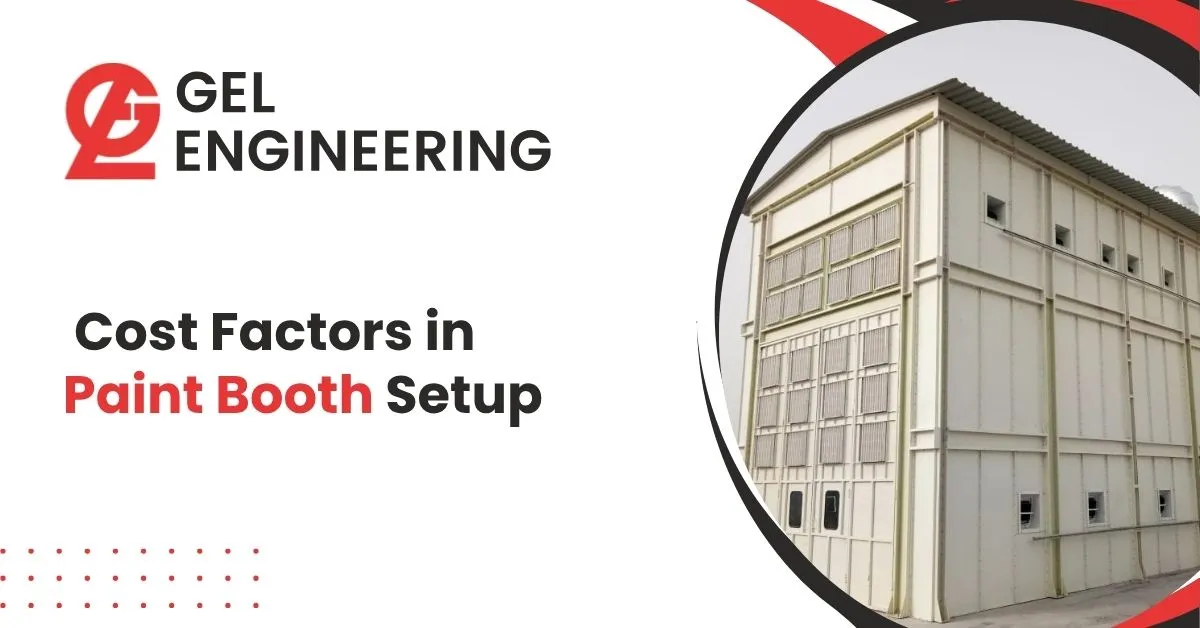
Setting up a paint booth—whether for automotive, aerospace, industrial, or furniture manufacturing—is a significant investment. The total cost depends on various factors, including size, functionality, safety features, and compliance requirements. Understanding these cost factors in paint booth setup enables businesses to plan effectively and optimize their return on investment (ROI).
Understanding the Investment Behind High-Performance Painting Systems
1. Type of Paint Booth
The design and functionality largely determine the cost. Common types include:
- Open-face booths: Most affordable, ideal for small-scale operations
- Enclosed booths (crossdraft, downdraft, semi-downdraft): More expensive but offer better overspray and contamination control
- Custom booths for aerospace or industrial parts: require specialized construction and systems
Example: A basic open-face booth may cost ₹3–5 lakhs, while a large downdraft booth with heating and AMU can exceed ₹40–50 lakhs.
2. Size and Configuration
The booth’s dimensions must match the product size and production volume. Larger booths require more structural materials, air handling capacity, and floor space, driving up both material and installation costs.
Factors impacting size-related cost:
- Product dimensions
- Batch vs. continuous production
- Additional space for curing or prep
3. Airflow System and Ventilation
Airflow style (crossdraft, downdraft, or side-draft) affects both performance and price. Downdraft booths, for example, offer superior finish quality but require a pit or raised floor, increasing construction and operational costs.
Airflow-related costs include:
- Ducting
- Fans and blowers
- Pits or raised steel grates
- Exhaust stacks and sound dampeners
4. Heating and Air Makeup Units (AMU)
An Air Makeup Unit (AMU) introduces pre-heated, filtered air into the booth to maintain temperature and compensate for exhaust losses. It’s essential for maintaining coating quality and curing speed, but it adds significantly to overall costs.
AMU can cost ₹10–15 lakhs or more, depending on capacity and automation.
5. Filtration and Environmental Compliance
Paint booths must comply with local pollution control norms, which may include:
- Overspray filters
- Activated carbon filters for VOCs
- HEPA filters for cleanroom-grade applications
Costs rise based on the level of environmental regulation and the need for waste treatment systems.
Need a custom paint booth setup? Contact us today for expert guidance and cost-effective turnkey solutions.
6. Lighting and Safety Equipment
Installing explosion-proof lighting, emergency cutoffs, and fire suppression systems is mandatory for safety compliance under NFPA 33 and IS 4894 (India). These features are critical but often add 10–20% to the overall cost.
7. Automation and Control Panels
Modern paint booths often come equipped with PLC-based control systems for temperature, humidity, and airflow management. While automation increases upfront costs, it enhances process reliability and reduces labor costs in the long run.
8. Installation, Commissioning & Civil Work
Civil work, foundation, electrical wiring, and on-site installation are significant cost contributors. If the booth requires pits, exhaust stacks, roofing adjustments, or panel insulation, expect the project cost to rise accordingly.
9. Customization and Add-Ons
Every business has unique needs—custom doors, integrated conveyors, loading systems, lifts, or robotic arms can significantly impact final pricing. Custom booths for defense, aerospace, or heavy industries may need additional features like cleanroom compatibility or blast-proof construction.
Frequently Asked Questions
What is the average cost of setting up a paint booth in India?
The average cost of a basic paint booth in India ranges from ₹3–5 lakhs for open-face models, while a fully enclosed downdraft booth with an AMU and compliance features can cost upwards of ₹40–50 lakhs, depending on size, automation, and industry standards.
Which factors affect paint booth pricing the most?
Key cost drivers include:
- Booth type and size
- Airflow system (crossdraft, downdraft, etc.)
- Heating & ventilation (AMU)
- Filtration & environmental compliance
- Automation & control systems
- Safety equipment
- Civil and installation work
Is it necessary to include an Air Makeup Unit (AMU)?
Yes, especially in enclosed booths. AMUs help maintain temperature, improve airflow, and reduce contamination. They’re also critical for consistent curing and meeting industrial safety standards such as those outlined by OSHA and IS codes.
Are paint booth setups subject to environmental regulations?
Yes. Paint booths must comply with regulations from local Pollution Control Boards and international standards (like EPA and ISO) regarding VOC emissions, air filtration, and waste disposal. Using proper filtration systems is mandatory.
How long does it take to install a paint booth?
Depending on the size and complexity, installation and commissioning can take anywhere from 2 to 8 weeks. Custom booths with civil work or automation systems may take longer.
Conclusion
A high-performance paint booth setup is a long-term investment that depends on various engineering, safety, and operational requirements. By understanding these cost factors, companies can make informed decisions that balance quality, compliance, and budget.

